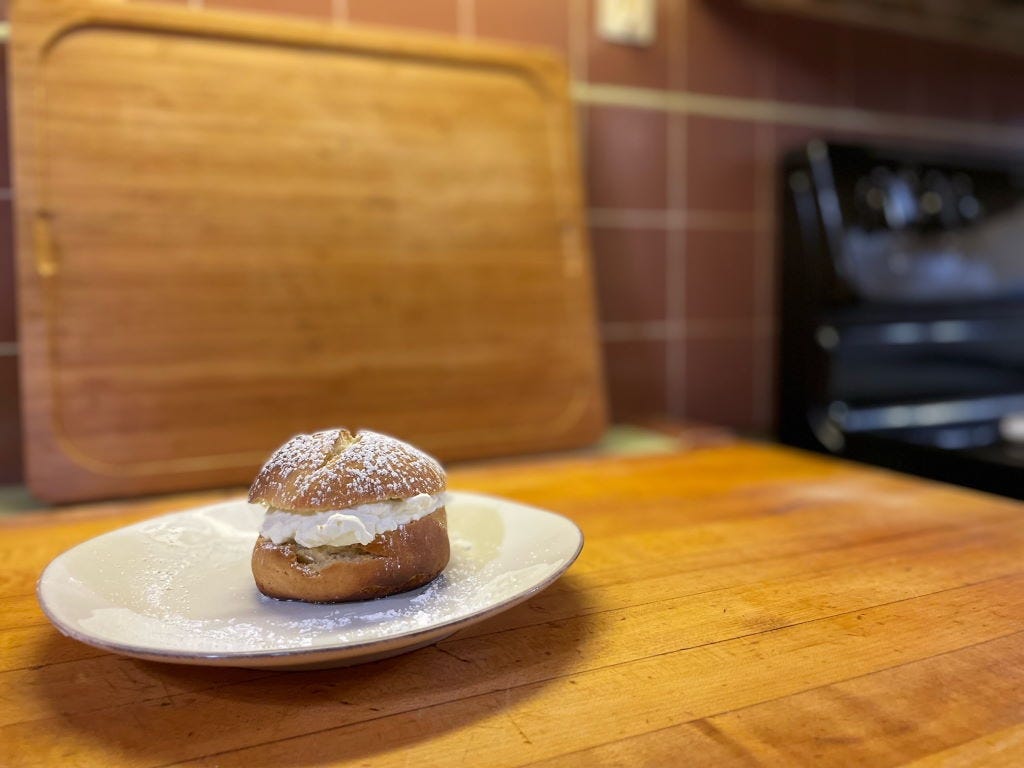Fastelavn
During childhood, I firmly believed Fastelavn—the Sunday forty-nine days before Easter—was a tradition created solely for eating cream-stuffed buns. The belief is not as far-fetched as it sounds: pastry recipes were the only mention the day received on TV and in newspapers. I may have suspected Fastelavn to be a religious tradition, but up until recently, I held no concrete proof.
A recent scour of Wikipedia provided some information, with an emphasis on “some.” Their Fastelavn article is a garbled mess of history and etymology, but from what I can garner, the day is rooted in the Roman-Catholic carnival leading up to Lent. At some point in the 1800s, that tradition made its way up north and integrated into Lutheran culture. In other words, it’s the Northern European version of Mardi Gras and a very muted one at that. The extent of revelry begins and ends with cream buns.
These days, Fastelavn is primarily a mainstay in Denmark, where the name also originated from. It roughly translates to “the evening before fast,” even though it takes place three days before Lent. I suppose “Fastetredagefør” doesn’t roll off the tongue.
Fastelavn buns—fastelavnsboller—are sweet buns filled with cream and topped with powdered sugar. In later years, there have been different takes, but I’ve included a more traditional recipe. This one is courtesy of Tine, Norway’s de-facto monopolized dairy producer.

Recipe For Fastelavnsboller
Ingredients
Buns
- 8 tbsp unsalted butter (1 stick)
- 1 ¼ cup milk
- 3 tbsp cinnamon
- 4 ½ tbsp active dry yeast (2 envelopes)
- 1 tbsp sugar + ¾ cup sugar
- 1 egg + 1 beaten egg
- 1 tsp salt
- 4 cups all-purpose flour
- Powdered sugar
- Strawberry jam (optional)
Whipped Cream
- 1 cup heavy cream
- ¼ cup sugar
- 1 tbsp vanilla
Steps
- Melt butter in a small pot over medium heat.
- Add milk and cinnamon and let it heat right up until pre-simmer.
- Remove from heat and cool until it is lukewarm.
- Pour half a cup of milk mixture into a large bowl, and stir in yeast and 1 tbsp of sugar.
- Let sit until yeast bubbles, approximately 3-5 minutes.
- Add remaining milk mixture, ¾ cup sugar, egg, and salt.
- Gradually stir in flour until the dough is firm.
- Turn the dough onto a floured surface and knead for 10 minutes.
- Put the dough in a lightly greased bowl and cover with a damp cloth. Let rise for an hour in a warm spot.
- Meanwhile, preheat oven to 425˚.
- After an hour, punch down dough, and divide it into 12 evenly sized smooth rolls. Brush butter around each ball.
- Place 6 rolls on a parchment-covered baking sheet—or use 2 sheets with 6 each.
- Bake in oven until they turn golden brown. About 10-15 minutes.
- Remove from oven and let cool.
- When ready to serve, whip the cream.
- Cut each bun in half, top the bottom part with cream, and close it hamburger style.
- Cover each bun with a dusting of powdered sugar.
- You can optionally serve the buns with jam in addition to the cream.
In this year of the Lord, 2022, Fastelavn is observed on February 27th—give the buns a try if you want to explore a genuinely esoteric corner of Scandinavian traditions.
Web Source
“Fastelavn.” Wikipedia. February 17, 2021. en.wikipedia.org/wiki/Fastelavn
